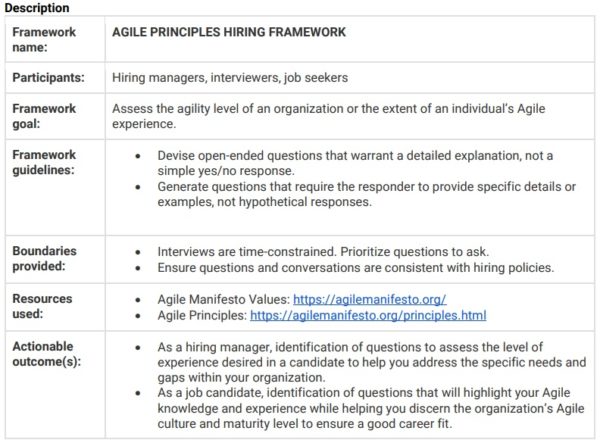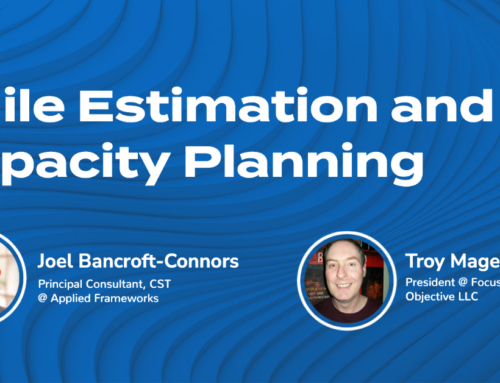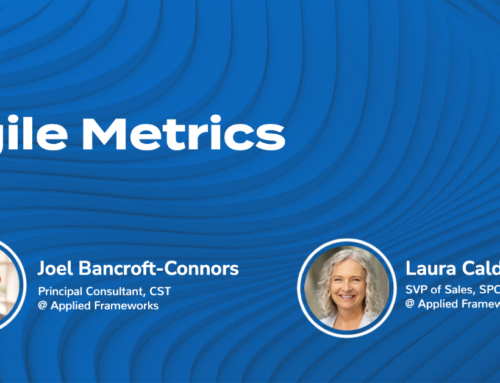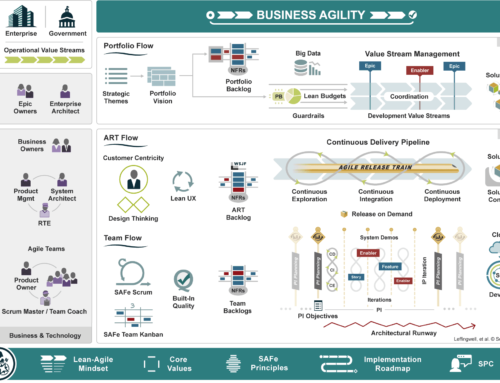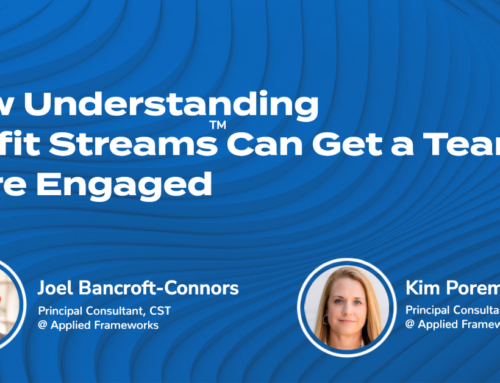How Agile are you? Whether you’re a job seeker or a hiring manager, these Agile interview questions will give you a clear answer.
My Agile and Scrum journey began in 2008. Prior to that time, I had spent 13 years working as a Business Systems Analyst. The projects I worked on spanned months, sometimes years, and I painstakingly authored hundreds of pages of requirements documents for each. Several of the projects I worked on were cancelled mid-flight when priorities shifted and budgets ran out. It was exciting but rare to experience a project actually go live. Moving to an Agile way of working was fulfilling and fun. I enjoyed the continuous collaboration with my team members. Their self-organization was refreshing having spent so many years working with teams that relied on me to tell them what to build and how to build it. It was rewarding to launch valuable new features and functionality to our customers in a matter of weeks or months, not months or years.
I vowed that I would never work for another company that was not Agile.
Fast forward to 2013 and my family decided to relocate to another state. I accepted a position with a company that I I believed was in the early stages of Agile adoption and moving forward. In fact, I was hired because of my extensive Agile experience. However, once I got acclimated, it was apparent that my new company was not Agile in the least. I chided myself for not asking the right questions during the interview process to better assess the company’s level of agility.
But what are the “right” questions to ask? As a job seeker, a prospective employer may truly believe they are Agile. Likewise, as a hiring manager, a prospective candidate may truly believe they are Agile because their only experience has been with their current employer. Other job seekers may try to fudge their way through the interview process by watching a few YouTube videos about Agile prior to their interview. One approach you can experiment with as a hiring manager or job candidate is to leverage the Agile Manifesto and its 12 principles as a framework to devise questions to assess agility.
Agile Interview Questions for Hiring Managers
As a hiring manager interviewing for a Scrum Master, Product Owner, or Development Team member position, consider the following questions, guided by the Agile principles highlighted below.
To Scrum Masters:
Agile Principle #5 – Build projects around motivated individuals. Give them the environment and support they need, and trust them to get the job done.
- Describe a situation in which the Development Team was not self-organizing. What did you do to promote self-organization?
- Describe a situation in which the Development Team was being told how to do their work and was not trusted to get the job done.
What to look for…
The intent of these questions is to understand if the Scrum Master candidate understands the concept and importance of self-organization and can provide concrete examples of their coaching abilities and tactics.
Agile Principle #12 – At regular intervals, the team reflects on how to become more effective, then tunes and adjusts its behavior accordingly.
- Describe a typical retrospective for your team. How does the session flow? What tools and/or activities do you use to facilitate the retrospective?
- Describe a situation in which a retrospective you facilitated helped the team address a major issue and/or resulted in a significant improvement for the team.
What to look for…
The intent of these questions is to understand if the Scrum Master candidate knows how to conduct an effective retrospective that is interactive, engages the whole team, and results in actionable items that contribute to the team’s continuous improvement.
To Product Owners:
Agile Principle #10 – Simplicity–the art of maximizing the amount of work not done–is essential.
- Describe a situation when you were able to successfully deliver a product or feature earlier than planned by maximizing the amount of work not done.
- Describe a situation when you had to say no to a stakeholder. Why did you decline the request? How did they react? How did you justify your decision?
What to look for…
The intent of these questions is to understand if the Product Owner candidate understands the importance of product backlog prioritization, breaking down work into small, negotiable backlog items, respecting the Development Team’s plan for the Sprint by not injecting unplanned work, and remaining true to the product goals, vision, and roadmap.
Agile Principle #4 – Business people and developers must work together daily throughout the project.
- Describe a typical day for you as a Product Owner. Who do you interact with? What meetings or events do you attend? What activities do you engage in?
- Describe how you prepare the product backlog for the upcoming sprint.
What to look for…
The intent of these questions is to understand if the Product Owner candidate is an active member of the Scrum Team and makes themselves available to the team on a daily basis. Additionally, these questions can help the hiring manager understand if the Product Owner conducts backlog refinement with the team and actively reviews and accepts work throughout the Sprint.
Agile Value #4 – Responding to Change over Following a Plan
- Describe a situation where you pivoted on the direction of a product or feature after learning key insights.
What to look for…
The intent of this question is to understand if the Product Owner candidate uses empirical data to adapt the product or service to optimize value delivery.
To Development Team Members:
Agile Principle #4 – Business people and developers must work together daily throughout the project.
- Describe a typical day for you as a Development Team member. Who do you interact with? What meetings or events do you attend? What activities do you engage in?
What to look for…
The intent of this question is to understand if the Development Team member candidate is accustomed to working in a collaborative environment, engages routinely with the Product Owner, and actively participates in Scrum events and backlog refinement.
Agile Principle #6 – The most efficient and effective method of conveying information to and within a development team is face-to-face conversation.
- How do members of your team determine who will work on which items? How is work assigned or distributed?
What to look for…
The intent of this question is to understand if the Development Team member candidate is accustomed to working in a self-organizing team, working on the highest priority items first, and limiting work in progress. Assess if the candidate mentions the Daily Scrum as a means to coordinate work. Be aware of anti-patterns the candidate may mention such as work being assigned to team members by a technical lead or all tasks being pre-assigned in Sprint Planning.
Agile Principle #9 – Continuous attention to technical excellence and good design enhances agility.
- Describe some of the development practices you use to continually elevate technical excellence on your team.
What to look for…
The intent of this question is to understand if the Development Team member candidate engages in development practices such as pair programming, test-driven development, peer reviews, adherence to coding standards, continuous integration, etc.
Agile Interview Questions for Job Seekers
As a job seeker interviewing for a Scrum Master, Product Owner, or Development Team member position, consider the following questions, guided by the Agile principles highlighted below.
For Scrum Masters:
Agile Principle #5 – Build projects around motivated individuals. Give them the environment and support they need, and trust them to get the job done.
- Describe the structure of a typical Scrum team. Which roles are on the team? How many people? Are teams organized around products or projects? How long do teams stay together? Are team members dedicated to one team or shared across multiple teams?
What to look for…
The intent of this question is to understand the prospective employer’s team structure as it relates to agility. Agile anti-patterns include teams that are too large, teams that are not cross-functional, teams that are formed and disbanded for projects instead of being long-standing with dedicated team members, and teams that are project, not product focused.
Agile Principle #12 – At regular intervals, the team reflects on how to become more effective, then tunes and adjusts its behavior accordingly.
- Which Scrum events do teams engage in?
- How does the organization engage in continuous improvement?
- What metrics does the organization track?
What to look for…
The intent of these questions is to understand if the prospective employer’s teams engage in Sprint retrospectives and embrace continuous improvement. Understanding the metrics the organization tracks can provide insights into what it values and whether any metrics it tracks are indicative of anti-patterns. For example, comparing teams’ effectiveness based on sprint velocity would be an anti-pattern.
For Product Owners:
Agile Principle #1 – Our highest priority is to satisfy the customer through early and continuous delivery of valuable software.
- What is the typical release cycle?
- How does the company engage its customers to solicit feedback and prioritize features?
- How is work prioritized?
- How does the company measure customer satisfaction?
What to look for…
The intent of these questions is to understand the prospective employer’s level of customer-centricity. Answers to the above will indicate if the employer embraces iterative and incremental development so that customers see value delivery early and often and if the employer has established customer feedback loops such as regular customer council meetings.
Agile Principle #4 – Business people and developers must work together daily throughout the project.
- How do Product Owners engage with the Development Team?
- Are Product Owners considered part of the team?
- Who facilitates and participates in Sprint Reviews?
- How does the Product Owner acknowledge that work is complete?
What to look for…
The intent of these questions is to understand how the Product Owner role is performed at the hiring company. A Product Owner who is not actively part of the Scrum team is an agile anti-pattern. These Product Owners do not embrace whole team ownership, rather an “us-them” mentality exists between the Product Owner and the team.
For Development Team Members:
Agile Principle #3 – Deliver working software frequently, from a couple of weeks to a couple of months, with a preference to the shorter timescale.
- What is the typical release cycle? Even if code is released in production, is it publicly launched to customers?
- How are production defects identified and prioritized? Who fixes production defects? Is there a separate Production support team?
What to look for…
The intent of these questions is to understand how often a prospective employer releases new functionality and gain insights into the company’s quality practices. An anti-pattern is holding code in a staging environment or releasing code to production but not activating it for customers. This limits the ability for teams to gather customer feedback to inspect and adapt. Inquiring about defect management helps a job seeker understand how many Production defects exist and whether teams fix their own defects so they can learn from their mistakes, improve test scripts, and revisit their Definition of Done.
Agile Principle #11 – The best architectures, requirements, and designs emerge from self-organizing teams.
- What are some ways that teams demonstrate self-organization?
- How are designs vetted?
- What is an example of a time the team “failed fast” and learned?
What to look for…
The intent of these questions is to understand the culture of the prospective employer. As a job seeker, you will want to know if designs and plans for Sprints are dictated to the team or if the team devises their own. The above questions can also help discern if the company embraces experimentation or is overly cautious and risk averse.
Agile Principle #8 – Agile processes promote sustainable development. The sponsors, developers, and users should be able to maintain a constant pace indefinitely.
- How is work estimated for a release? For a sprint? Who estimates? How often are estimates reviewed and revised?
- What is the team’s velocity? How often does the team complete its sprint plan?
What to look for…
The intent of these questions is to understand if the prospective employer is heavily date-driven and focused on output versus outcome. If so, it’s likely that teams work a lot of overtime to meet unrealistic deadlines.
Conclusion
The questions above are merely a representative sample to illustrate how you can use the Agile Manifesto and its twelve principles as a framework for identifying Agile interview questions. You will want to leverage the framework to devise your own questions based on your personal experiences. Also keep in mind that while the questions are designed to assess agility as a hiring manager or job seeker, the weight you place on the responses will vary. One job candidate may seek a position in a well-established Agile environment. Another job candidate may seek a position in a company that is still early in its Agile journey with the desire to take a more active role in guiding its transformation. Case in point, despite my initial disappointment in joining a company that was not as Agile as I was led to believe, several years later, I was selected to be part of that company’s Agile transformation effort. It was an experience that has had a profound impact on my career path and trajectory.
By leveraging the Agile Manifesto and its twelve principles as a framework for your next interview, you can gain valuable insights and drive meaningful conversations to more confidently arrive at a hiring or career decision.
To assist, we provide a downloadable hiring framework, shown below.
*Note: Thanks to Kim Brainard who introduced this approach to me.
If you would like more information or help with this hiring framework or other frameworks that can help your Agile Transformation, you can contact one of our experts to see how we can help.
And be sure to follow us on Linkedin, Twitter and/or Facebook to hear when new blogs are published and webinars are scheduled on interesting Scrum and Agile topics.


